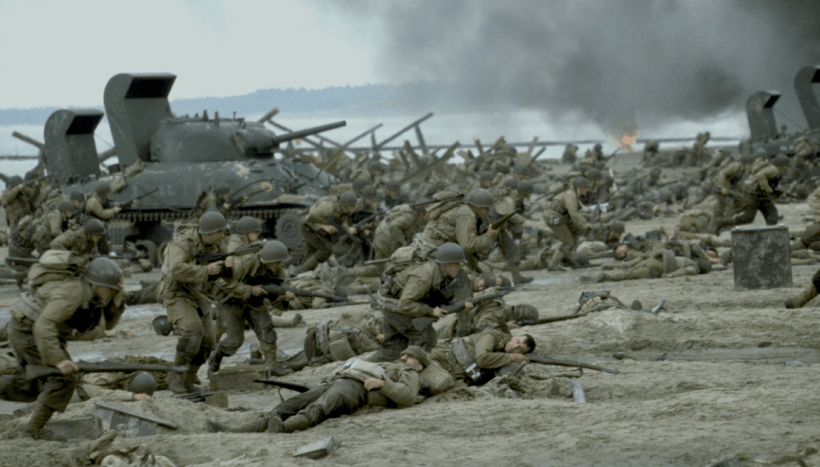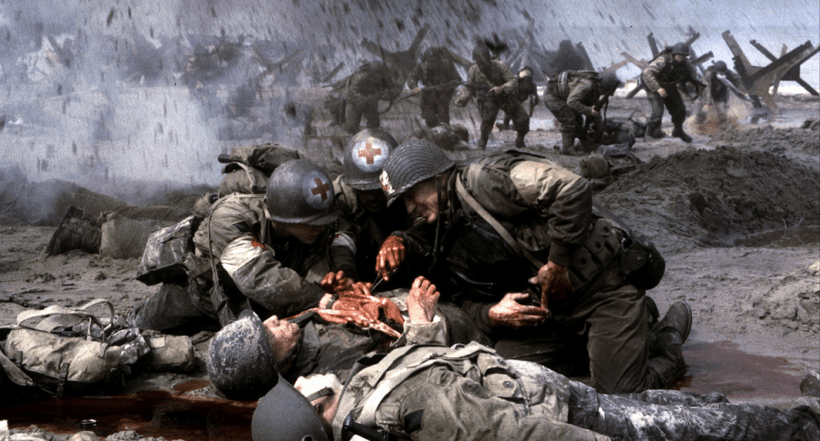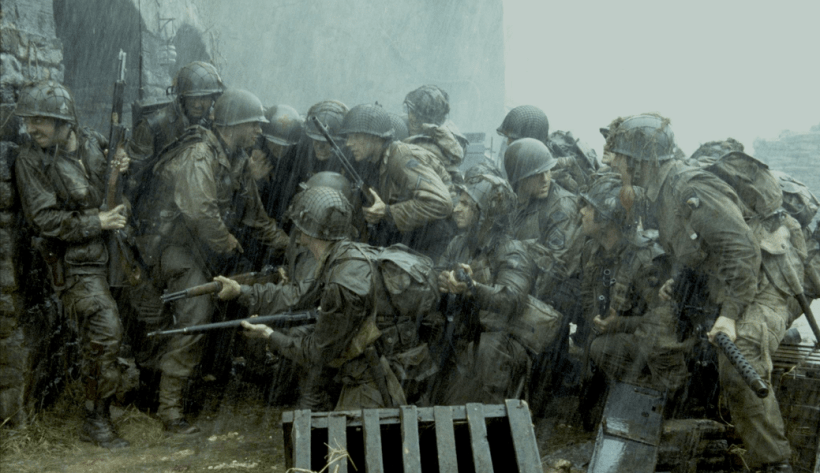Saving Private Ryan (1998)
Rated R
(for intense prolonged realistically graphic sequences of war violence, and strong language)
Released: July 24, 1993
Runtime: 169 minutes
Director: Steven Spielberg
Starring: Tom Hanks, Edward Burns, Tom Sizemore, Jeremy Davies, Barry Pepper, Adam Goldberg, Giovanni Ribisi, Vin Diesel, Matt Damon
Day 20 of “30 Days of Spielberg”
I’m just going to get this out of the way upfront:
Shakespeare In Love deserved to win the Academy Award for Best Picture over Saving Private Ryan.
Look, if the decision were based solely on the opening D-Day sequence (which, undoubtedly, is how Steven Spielberg took home his second Directing Oscar, and rightfully so), then yes, Saving Private Ryan would’ve been the clear choice. But there were two more hours to contend with and, as a whole, Shakespeare In Love is a perfect expression of its inspired conceit from start to finish. Saving Private Ryan is not. The Academy got it right.
As with Amistad (and all four of Spielberg’s “noble” American history films – with Lincoln and Bridge Of Spies to follow), Saving Private Ryan falls prey to talking too much. The discussions here aren’t particularly provocative, either, serving more as CliffsNotes of aspects from Just War Theory debates.
Indeed, the conversations these soldiers undertake are more akin to a group of Ethics professors (or perhaps their students), not army grunts in the thick of it. Each character archetype throws in another pat perspective from the proverbial syllabus, along with stock sentiments and regrets, but little more.
Too much philosophizing and speechifying make Saving Private Ryan too self-conscious of its own desired import, especially coming after the visceral chaotic inhumanity we saw on the beachheads of Normandy. (That epic of carnage truly gave us something to meditate on and think about.)
Now, with that little bombshell opinion out of the way:
Here’s the reason why it was vital for Spielberg to have made Saving Private Ryan exactly the way that he did.
Saving Private Ryan came out in the summer of 1998, three years before 9/11. As a nation, we were still ambivalent about soldiers and war in the long perpetual wake of Vietnam. The first (and successful) Gulf War in 1991 was the first historical marker to positively shift our collective national perception of soldiers and veterans, from the disrespect and neglect that followed the Vietnam campaign to finally appreciating, valuing, and honoring their service and sacrifice once again.
But that was just a beginning. The wheel was still turning. And when it came to films, war movies were almost universally anti-war. They were all critiques with politicized strains; not so much stories, but indictments.
Then came along Saving Private Ryan, the first Hollywood war movie in more than a generation to unabashedly – even humbly – honor the sacrifices of our soldiers, and of our veterans. It even forced us (rightfully) to ask of ourselves if we were living lives worthy of those sacrifices. Saving Private Ryan was, in effect, the first war picture to salute The Greatest Generation since their kids’ generation rebelled against them – and everything they stood for.
And it came from a Baby Boomer.
The United States needed a movie like this, from a filmmaker like this, saying things like this. It wasn’t just important that it was made, but who made it. Despite being heavy-handed at times, our culture needed the sermon. It wasn’t Pro War. It was Pro Solider. And it was all gratitude. (I can’t imagine anyone better suited than Tom Hanks to personify the unassuming virtues of those soldiers we were grateful for.)
The film’s tone and worldview may have been a throwback, but the filmmaking of Saving Private Ryan was downright revolutionary. The drop-frame technique mixed with handheld movement (all desaturated in crunched colors and shadows) created an aesthetic of chaos previously unmatched, and was perfectly conceived to capture the experience of modern warfare at new empathetic levels.
The 20-minute Normandy invasion is a landmark in film history, but then it’s essentially matched (at moments even surpassed) in the climactic “hold the bridge” battle at Ramelle. Though more limited in geographic scale, that finale incorporated even more complex aspects of choreography between action, camera, and real-time warfare recreation. (Combined, the two sequences of Normandy and Ramelle make up nearly an hour of the film’s run time.)
We get some of Spielberg’s most impressive Oners, too. Not only do some shots in the Normandy sequence last longer than its mostly quick-cutting approach would suggest, but the finale battle has a 45-second track that goes from exterior to interior, constantly shifting frames, before coming back outside again – all perfectly timed to match the progress of tank movement, mortar fire and various explosions.
There’s also a more subtle Oner, 1:41 in length, in which two platoons fight to hold and advance through a rainstorm. Like all of the combat scenes, this one lengthy shot has a lot of moving parts within it, including the platoons as they constantly shift, advance, and reposition. This Oner tracks it all, but in a way that doesn’t draw overt attention to itself. Its subtlety is achieved by resting on a new frame once it’s created (rather than having the camera continue to float or stay in motion) before moving again to another.
Spielberg – along with his cinematographer Janusz Kaminski and editor Michael Kahn (who each won Oscars along with Spielberg for their groundbreaking efforts, as did the crews in both sound categories) – not only changed forever how war is depicted on film but, more broadly, how action is depicted. Saving Private Ryan’s influence can be seen everywhere from the Jason Bourne franchise to TV’s 24 to countless other movies and shows in-between.
John Williams score, by stark contrast, never underscores the warfare, but only the more sober stretches that play out in-between combat. His music serves not to amplify action; it’s an elegy to our Armed Forces.
Yes, Saving Private Ryan was (and is) a powerful, gut-wrenching experience unlike any war movie we’d ever seen; but more importantly, it was the final seal on a necessary, long-overdue corrective to respect our soldiers and veterans that we, as a nation, so desperately needed.
Currently streaming on Netflix, and available to rent through Amazon Instant Video.
NOTABLE TRIVIA
- Spielberg didn’t exactly decide to cast Hanks. As it happened, both Spielberg and Hanks just happened to be reading Robert Rodat‘s script at the same time while it was making its rounds in Hollywood. When they both learned that the other was reading it, and that they each shared an equal passion for it, they decided to make the film together. Prior to that, Spielberg was debating between Mel Gibson and Harrison Ford for the lead role of Capt. John Miller.
- This would be their first of now four collaborations between Spielberg and Hanks. They also produced the HBO miniseries Band Of Brothers.
- Spielberg hired the then unknown Matt Damon in the pivotal role of Private Ryan because of the strong recommendation from close friend Robin Williams, who was in the middle of shooting Good Will Hunting with Damon at the time.
- The only film Spielberg never made storyboards for was Schindler’s List. Second to that, Spielberg didn’t make or follow any storyboards for the Normandy invasion, instead choosing to shoot on gut instinct. They spent an entire month shooting that one sequence, at a cost of $12 million.
- There was a risk that, due to the film’s extreme violence, the film could’ve received an NC-17 rating. If it had, Spielberg said he would not have made any cuts and released it with that rating.
- Saving Private Ryan notched two big firsts for DreamWorks studios: their first film to pass the $100 million mark at the box office, and the first to be nominated for Best Picture.
- To the point about how the culture was still largely disrespectful towards soldiers and veterans, Spielberg thanks his dad during his Best Director Oscar speech for helping him see that there’s honor in respecting the past.
- In 1993, Harrison Ford presented the Best Picture Oscar for Schindler’s List to his close friend Steven Spielberg. In 1998, Ford once again announced and presented the Best Picture prize – which made the Shakespeare In Love upset (a film written by Spielberg’s Empire Of The Sun screenwriter Tom Stoppard, no less) that much more unexpected and dramatic.










Totally agree. It’s an amazing film in spite of its issues. Good review! Have you read William Goldman’s pretty scathing review of it?
http://achtenblog.blogspot.com/2007/08/saving-private-ryan-goldman-essay.html?m=1
LikeLiked by 1 person
I’ve not read it. Didn’t even realize it was a thing. Thanks for the link, Brian, looking forward to reading it!
LikeLike
Ah, I remember reading that article when it was first published in… Premiere magazine, I think?
LikeLike
It’s interesting that you’d see this film as a “corrective” to the Baby Boomer attitude. Some critics thought it actually reflected typical Baby Boomer narcissism, for example through dialogue that suggested the “one decent thing” these guys could get out of the war would be saving Private Ryan, and not, like, stopping Hitler or something. (See, e.g., .) The celebration of warriors *apart* from the actual wars they fight — the celebration of their service *apart* from the actual causes they serve — is deeply problematic on one level, but it’s a theme that has come up in many war movies since.
For what it’s worth, my own thoughts on the film have been all over the place; I wrote about that here over a decade ago (how the time flies!).
LikeLiked by 1 person
Hmmm, the two URLs I provided were expunged from my comment. Oh well.
LikeLike
While I didn’t feel that narcissism as strongly, it’s hard to deny when you make the point as you have. I’ve generally lumped that into the generic, pat philosophizing that I find to be the film’s primary weak spot. Also, it’s easy to sympathize with that sentiment being expressed in the heat of battle and warfare.
Even so, when rightfully acknowledging that Baby Boomer mindset was erroneously applied to their parents’ perspective on WWII (who were very committed to the war effort, for clear moral reasons), there’s no denying how different in worldview and tone – indeed, in stark contrast – this was to war movies post-Vietnam.
LikeLike
I wish some proof existed for the NC-17 rumors (including the one that he only got the R because he was Spielberg).
It’s interesting that in an interview Spielberg says that any war movie is an anti-war movie, as I agree with you that this one is at least pro-soldier if not pro-war.
The Normandy and Ramelle sequences are still amazing in that they feel so chaotic but still show Spielberg’s grasp of classical direction.
LikeLiked by 1 person
Yep, that’s the genius of those big battle scenes. They’re revolutionary yet classically made all at the same time.
In terms of the NC-17, it can’t be known how close it was to getting that rating. Spielberg only made his comment about it in the theoretical, saying he’d stick with his cut regardless of where the MPAA would land with it.
LikeLike